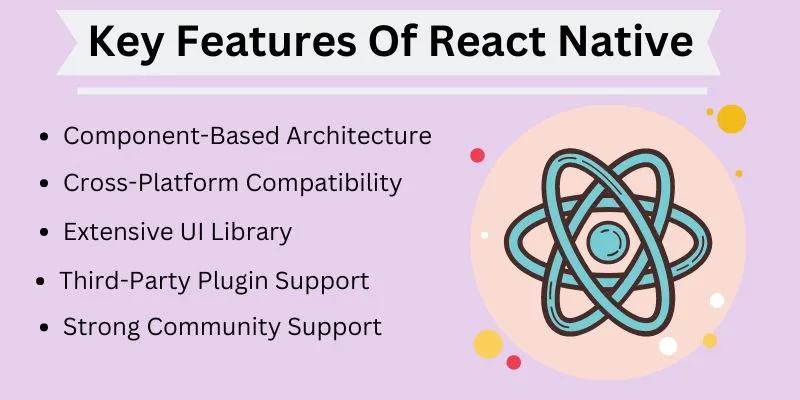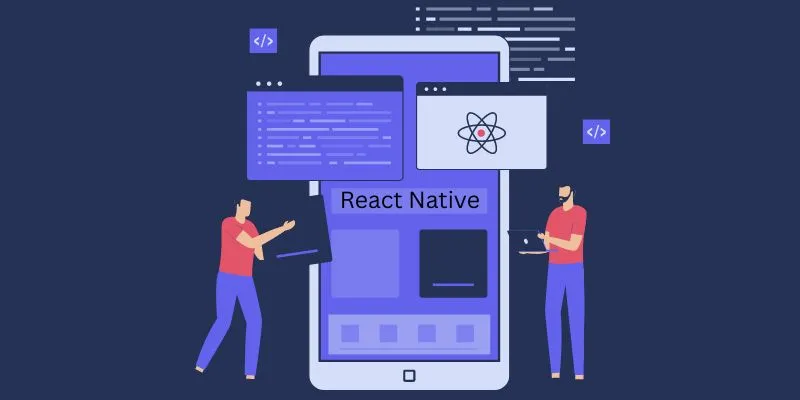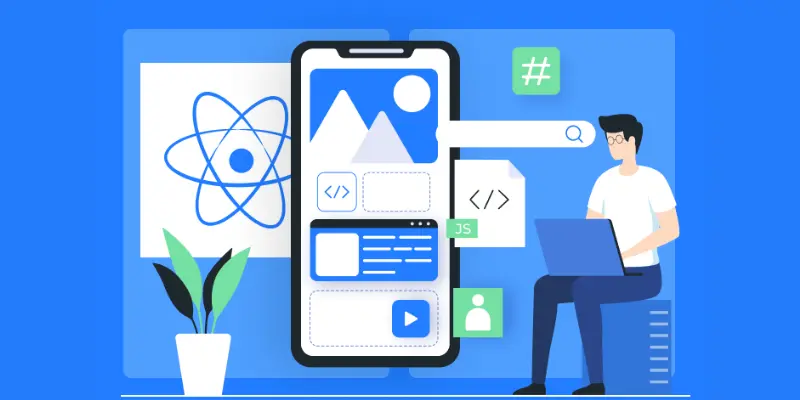The landscape is changing for developing cross-platform apps. React Native emerges as a revolutionary technology, embracing the market's current needs and seamlessly fitting into the stack of technology used by various cutting-edge software. React Native App Development offers an unbeatable blend of improved efficiency, flexibility, and the capacity to design high-end UI user experiences. It is positioned to be a platform-independent framework. However, before you set out into this journey of technology, a reliable company is essential, as well as a comprehension of the difficulties and best practices in React Native development.
Making applications with pre-built code, widgets, and designs could speed up creation. Frameworks are a great way to ensure a smooth development process and tested applications with faster launch times. With speedier deployment, companies are seeking to attract the most potential customers. The single codebase, reusable components, stable base, and one place to manage all phases of development for mobile applications make the framework a profitable choice for app developers.
React Native, Flutter, and Xamarin lead the frameworks for developing cross-platform apps. In this tutorial, we'll discuss React Native in detail. We will examine its most essential attributes, their importance to 2024, and avoiding errors while developing using this framework.
What Is React Native?
React Native is an open-source framework developed by Facebook that allows developers to create mobile apps with JavaScript and React. React Native is based on bridges that allow JavaScript code to connect with the platform's native APIs. This bridge enables React Native Developers to access native functions and components, including cameras, GPS, and push notifications, all while creating JavaScript code.
React Native is used mainly for developing mobile apps. It's especially well-suited to applications that need a higher performance quality, like gaming and streaming video. It is also a top option for businesses looking to build cross-platform apps since it allows users to reduce time and money by writing the code once and making it available across different platforms. If you use React Native, you only have to create your JavaScript application once.
In contrast, the native method involves starting from scratch using two applications, one designed for iOS and one for Android. To build using React Native, you must have two programmers writing codes. But the investment pays off, with significant development costs and maintenance reductions.
Read Also: How Much Does It Cost to Build a React Native App in 2024
How Does The React Native Work?
Let's examine the underlying principles of React Native and how they differ from what we've seen before. As we mentioned previously, React Native is written using a mix of JavaScript and JXL, a unique markup syntax akin to XML. React Native can connect with two worlds of JavaScript-based and existing native threads for apps. What is the mechanism for this communication? React Native utilizes a feature known as a "bridge." Even though JavaScript and Native threads are written entirely in different languages and formats, the bridge function allows bidirectional communication.
This means that even if you have an existing native iOS or Android application, you may use its components or move into React Native development. Furthermore, React Native enables developers to build specific versions of their applications to work with various mobile platforms, which can improve app performance and users' experience across all devices.
Key Features Of React Native

Below are a few of the essential attributes that make React Native Mobile App Development a popular option for developers:
Component-Based Architecture
The component-based architecture of React Native permits developers to create apps using reusable components, making the process easier to develop. This design, through better code organization and encapsulation, makes it much easier to control and maintain apps. It is a crucial idea for React Native mobile app development.
Cross-Platform Compatibility
React Native lets developers create their code once and distribute it to various platforms. Developers now have access to tools for developing apps with native user interfaces, making their jobs more straightforward and faster. It saves time, energy, and money while ensuring the same high performance across all devices, making it an excellent choice for entrepreneurs and developers.
Extensive UI Library
Its UI library includes a set of necessary already-built UI elements that allow developers to develop visually pleasing user interfaces. These features can be customized to provide various features and design components, allowing developers to speed up the process of designing apps and focus on constructing functional apps.
Third-Party Plugin Support
The compatibility of React Native with third-party plugins allows it to expand its capabilities without the need to write native codes. It includes plugins with a wide popularity range, including UI elements and design, navigation, databases and storage, and more. An excellent illustration of this can be found in React Redux, an open-source JavaScript library that manages app status. A concrete illustration of a good use of React Redux is its role in enhancing the app's capabilities within Accel.
Strong Community Support
The solid community support for React Native enhances its popularity with developers and encourages the continuous expansion of the framework. Developers can leverage the community's tools, including tutorials, forums, and third-party libraries, to optimize their workflow and constantly improve their knowledge about React Native.
Read Also: Best React Native Apps in 2024: 11 App Built on React Native
Benefits Of Using React Native For Mobile App Development
Although it's an excellent framework, you must determine whether it meets your needs in mobile app development. Let's examine how React Native App Development Services can aid your company.
Shared Codebase
If you use React Native, you don't have to create separate code for both platforms. You can write a single program and apply it to both platforms. You can also add minor tweaks to the code to create more targeted and platform-specific code. This allows faster integration into the core components and improves the user experience.
Hot Reload
The working environment whenever you want to change the application already built. The hot reload feature lets users see the modifications in the real-time setting. There is no need to alter your mobile app to make the update. It is easier for users to test the updates and determine if it is appropriate to proceed with the update.
It Supports Third-Party Plugins
If you are using React Native, you can use the plugins to develop applications. The framework is equipped with JavaScript plugins and native ones. You can use both to access the key features of your enterprise application.
Interactive Interface
Which users are likely to prefer native-looking user interfaces? Replacing the native style and feel will attract more people to the app. React Native allows the creation of applications that follow specific platform style guidelines. Additionally, the built-in declarative elements will enable you to develop the app to fulfill the individual needs of the user.
Real-Time Updates
Ensure the apps are current and compatible with the platform's requirements. Since React Native apps are built with JavaScript, updating them is straightforward. In addition, the feature of pushing code included within React Native makes it easier for users to start updates at the speed of light.
Modular Architecture
This is among the most significant benefits of the React native framework. It allows you to use programs developed by different projects and then use them independently. In the meantime, the testing team knows the software and algorithms employed to create the mobile app. They can design test scenarios to determine the app's performance and quality. This can save developers time and enhance their testing capability.
Backed By a Community
One primary reason developers choose React Native is the strong community support. Many dedicated developers are responsible for enhancing the app framework. They're constantly striving to expand their abilities and provide more efficient solutions. They can also assist users when they are faced with developing an application for mobile devices.
As the development speed for mobile apps grows, more advanced techniques and innovations are launched. It is essential to ensure that the framework can support the emerging demands of the business.
Efficient And High-Performing
The framework meets the demands of mobile phones. It uses the GPU to determine how interfaces are displayed. This provides better performance since the GPU doesn't have to run a processor. The GPU allows the framework to be fast and reliable.
React Native is an intensive development framework that requires experienced developer teams. For an app development team to complete it successfully, this process must be carefully managed from beginning to end. If you want to know more about the process of development, let's examine the steps necessary to create the development of a quality product.
Initial Project Setup
Following the initial clarification phase, both the React Native App Development Company, and the client decide the project's requirements and goals. The developers will then have to complete the initial setup of their project. This involves setting up an entirely new environment for the project and installing the required tools, such as Node.js, Java Development Kit, Xcode, Watchman, React Native, Exp CLI, and many more.
Architectural Decisions
A solid technical architecture is crucial to successfully developing a React Native application. Developers must make the right design decisions to create a scalable and reliable codebase. This could include state-management solutions, directory structure, navigation architecture, and styling methods.
Integrating Native Modules
Developers might consider native model integration to improve performance, use specific features on devices, or implement capabilities specific to a particular platform. Prior to integrating native modules, developers should identify which features aren't covered by the standard React Native components. The goal of integrating native modules is to enhance the user experience on diverse platforms.
Continuous Integration And Deployment (CI/CD)
CI/CD concentrates on automatizing, developing, testing, and deploying procedures, improving app quality, and speeding up time to market. Developers should follow CI/CD's best practices, which could comprise continuous integration automation, automated testing, a system for controlling version and quality assurance of code, and other such practices.
Monitoring And Analytics
Monitoring and analytics help React Native apps understand how their users behave within their applications, assisting developers in implementing the necessary adjustments to boost application performance. Various tools, such as React Native Performance Monitor, Sentry, Google Analytics, and many more, assist developers in tracking application performance, user interaction, and crash reports immediately.
Challenges In React Native App Development And Their Possible Solutions

React Native has become a formidable platform for creating applications across platforms. Like all technology, there are difficulties.
Issues With Performance
The first item on our list is focused on optimizing performance in React Native app development. This is an extremely typical issue, especially for older devices and when running more than one component simultaneously. However, it is possible to overcome this problem by simply enhancing the code using the most current version of React Native and minimizing the number of third-party libraries.
The Absence Of Modules That Are Required And APIs
React Native may be among the most effective frameworks for supporting various modules and APIs that accelerate the creation process. However, the issue is that React Native may not encompass all of the necessary solutions for tackling different tasks. Additionally, if the essential elements are in place but aren't updated to the most recent operating system version, it creates problems. But there's a solution to this issue. You can develop that component of your application with native technologies.
If the situation is more significant and you cannot locate a specific answer even in the native software, you could create your module. It may seem complex and lengthy. But it'll help you save time and effort searching for the suitable component.
Native App Developers Are Needed
When developing cross-platform apps, developers can rely on native developers, especially when they need to incorporate complex computations within the app. When this happens, the developers could need to transfer all computations onto the native component of their app, requiring an expert native developer.
Depending On Components From Third Parties
React Native offers many components explicitly tailored for custom applications, making It an invaluable solution. However, it's essential to remember that although these tools are readily available, not all are reliable. This is due in large part to the fact that some applications from third parties could not have gone through a thorough test, which may compromise the security and integrity of your application if you implement them with care.
But there's no need to worry! The secret to conquering the challenge is to exercise patience, focus, and leverage your experience. Before implementing a component, it is essential to study apps that have successfully implemented the modules. Furthermore, having a React Native app developer on your team may prove beneficial because they know how to spot possible component issues to ensure optimal outcomes.
iOS Testing And Deployment Problems
When apps are released on the Apple App Store, Apple leaves no room to chance. They follow the most stringent standards to guarantee the safety and security of applications. So, suppose you plan to make your application available on the Apple App Store. In that case, you must overcome several hurdles, such as establishing an Apple Developer Account, getting the appropriate certifications, passing tests, and meeting additional requirements.
The issue is further complicated because a few React Native app libraries are considered insecure or not compliant with Apple's standards. To overcome this problem, it is essential to work with someone who has been through this procedure before. Their experience can help simplify the process and ease worries about the possibility of rejection in the App Store's review process.
UI And UX Behavior And The Requirements
The importance of UI and UX can't be understated in getting the approval of application users. As time has passed, consumers have developed specific expectations for Android and iOS applications. An inability to live up to these high expectations, paired with poor performance or deviation from the experience offered by native apps, could lead to users leaving the application.
The best way to overcome this problem is to follow the entire testing process. It is vital to consistently examine your software, particularly in various phases of development. This allows you to spot problems and find solutions early and prevents them from getting worse into an unmanageable problem.
The Abstraction Levels Are Being Addressed
Developers face the problem of managing many abstraction layers. These include codes located between native platforms and React Native. React Native Developer. Although these layers provide additional capabilities, they create significant problems. Problems that occur at the React Native abstraction level can manifest as a glitch within the application, which makes it challenging to identify which layer is responsible for the problem.
The most effective solution for this dilemma is having a skilled development team with abstraction layers. A professional and experienced React Native programmer is equipped to quickly find the source of the issue and offer appropriate solutions. Utilising their skills will significantly decrease the time needed to identify and solve problems.
A Frequent Update To The Platform
While React Native is considered to be the best platform for creating cross-platform applications, it has gone through 58 official versions since its launch. The changes range from minor improvements to significant game-changing enhancements. React Native developers provide frequent updates, undoubtedly beneficial because they guarantee an ever-growing tool. However, this continuous development also indicates a potential negative: the absence of stability for the long term and dependency.
Get your team ready to take on any necessary changes to your application triggered by new updates or other triggers. By cultivating a sense of flexibility and readiness to change, you will ensure that your application stays updated and current with changing needs.
Problems Encountered While Diagnosing
If you are a programmer, you are a good indicator of the difficulty of debugging. React Native is no exception. In the case of debugging with React Native, various common issues arise. These include navigating errors, identifying leaks in memory, or identifying problems with synchronous programming. This requires meticulous analysis and problem-solving abilities to ensure the application is error-free and smoothly developed.
To address the issue, it's necessary to assemble a team of experienced developers capable of using React Native tips and tricks to debug your app and help address its deficiencies. In addition, the group will use valuable tools and resources such as React Native Debugger or Chrome DevTools to speed up the debugging process. Utilizing the team's collective knowledge and the tools available makes it possible to diagnose problems effectively when working with React Native development.
Code Reusability
React Native is an innovative cross-platform mobile application framework that enables developers to utilise one code base across various platforms - leading to cost and time savings for them and businesses. While code reuse is advantageous, it also opens the door to multiple issues, like compatibility issues, scaling issues, and problems when maintaining the codebase.
To address this issue, you should get help from a React Native app development company. They can help ensure your application is reusable, flexible, and easily maintained across different platforms. Furthermore, they will guide you in implementing the best practices to manage dependency on code and eliminate the impact of compatibility issues when you partner with the React Native app development company. This will lead to better multi-platform app development.
Native Functionality Is Limited To a Certain Extent
Although React Native provides code reusability to support iOS and Android app development, it does not offer the same native capabilities as other frameworks for mobile app development. However, there are challenges with specific devices, and integration with APIs native to the device is necessary.
To deal with this, the best approach to address this issue is first to determine the primary native functions that are required and then add them to the React Native app. Furthermore, using third-party libraries and implementing customised solutions will help fill any functional gaps. When you carefully evaluate and integrate the required components, it will enhance your overall performance and provide an effortless user experience within Your React Native application.
Top Mistakes To Avoid During React Native Development
No two frameworks are identical. Additionally, the method of development suggested by the developers might vary. These can result in errors in the development of mobile apps. Below are the common errors you must avoid while designing a React Native mobile app.
Layout Estimation Mistakes
Using the same designs to design the app's layout is possible. However, the layout may vary in certain areas for Android as well as iOS. The design guidelines are crucial. The layout of forms should be checked prior to committing to it. Writing a couple of additional lines of code to determine the layouts correctly is possible.
Redux Storage Planning
When designing layouts, it is possible to overlook data storage and retrieval. Redux aids in data storage, debugging, and planning the app's states, which is crucial for safe mobile apps. Before applying Redux, a proper plan can be incorporated into the task list. In addition, a different solution than Redux can be chosen for more minor project needs.
Do Not Write Unit Tests
They're essential for testing the capabilities of applications. However, most developers have to record the various functions and the processes they use to develop the app. The result is that mistakes in the application are not noticed. Creating unit tests and examining every part of mobile applications is crucial.
Console.log Statements
They can be extremely beneficial in React Native app development. However, including them in the application is an error. They may affect the rendering processes and the performance of your application.
Incorporating Stateless Components
Stateless components do not have any type. They consider any argument as displayed and are included in the DOM. You may, however, not need to utilize stateless elements to satisfy all development requirements. Use pure components because developers can communicate AJAX requests and execute DOM operations without hiccups.
Wrong Estimates
In most cases, app developers must consider the smaller areas of app development that take time and effort. This means the timelines might not allow the app to be developed entirely. This is why it's essential to establish the scope of work down to the minute detail before defining the timings.
React Native App Development Best Practices
Despite the difficulties, a few guidelines can help accelerate React Native app development. We'll look at them.
Use TypeScript
TypeScript expands JavaScript by adding static type-checking and other features. It assists developers in catching mistakes earlier, enhances the quality of code and its readability, and improves the productivity of developers and tools. React Native supports TypeScript out of the box. Additionally, the most popular frameworks and libraries, such as Redux, React Navigation, and Expo, will easily work with it.
Make Use Of Functional Hooks And Components
Functional components are easier and less cluttered than classes-based components. Additionally, they allow developers to utilise hooks, the latest method to manage states and effects that are side effects in React. Hooks allow you to transfer and reuse logic among components, stop unnecessary re-rendering, and also access the React Native API.
Use a State Management Library
State management is one of the most complicated and crucial elements of the React Native app. It involves keeping track of the application's information and UI status and ensuring that they're consistent and synchronized. State management libraries that manage states, like Redux, MobX, or Recoil, will help programmers manage their state centrally and consistently. Also keep prop drilling out of the way, leading to unnecessary rendering or state inconsistency.
Use a Navigation Library
Navigation is an important aspect of a React Native application. It involves moving between elements and screens while offering feedback and a variety of transitions for users. The navigation libraries that support navigation, like React Navigation, React Native Navigation, and React Router Native, can assist developers in implementing navigation in a clear and modular fashion while also supporting different navigation styles, like drawer, tab, stack, and modal.
Use Expo
Expo is a collection of services and tools that help simplify and speed up the creation and implementation of React Native apps. It offers a managed workflow that manages the app's setup and configuration. Expo lets developers access native APIs and features, including cameras, location sensors, and notifications, without writing native codes. Expo offers an unmanaged workflow that gives developers more control and freedom over native code. It also allows the creation of custom native modules and libraries.
The Future Of React Native
As React Native is already a top platform for cross-platform apps and services, we anticipate an increase in capabilities across platforms. Integration of cutting-edge technology is also a major focus for many firms. One technology that could revolutionise mobile app development through React Native is the integration of AI.
AI in software development gives both companies and developers a distinctive knowledge of customers' behaviour and workflows, facilitating the process and providing customers with customised solutions to improve the user experience. AI, IoT, and virtual reality offer new possibilities for building immersive and engaging apps.
In the long run, we expect to continue working to enhance the efficiency of React Native apps, with the goal of faster and more effective solutions. These could include upgrades that concentrate on improving performance and enhanced platform support, as well as the introduction of React Native Fabric. This innovative architecture increases the interoperability of host platforms and provides new features for React Native.
Conclusion
With the development of mobile apps increasing, React Native helps developers create engaging and user-friendly apps that work on both iOS and Android. It is a time-saving and expense-effective option, Making it a great choice for all kinds of companies, regardless of the sector or specific intended audience.
Developers and businesses alike adore the framework. It lets you cut down on time, which results in a more straightforward development process and is cost-effective. This allows you to reach an even more significant number of users simultaneously since one application can now serve Android and iOS users simultaneously. Launches could be synced, and companies with less budget to develop don't need to pick a platform. React Native app development comes with some challenges. Following good practices and working with experienced teams will result in the successful creation of solid cross-platform mobile applications.














Share this blog